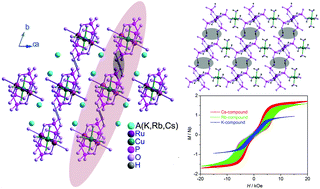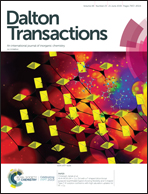Alkali counterions tune diruthenium(iii,iii)-based ferrimagnetic chain structured antiferromagnets exhibiting step-like hysteresis loops†
Abstract
The synthesis of antiferromagnets (AFMs) has attracted extensive attention in the area of magnetic devices, such as spintronics and memory devices. Following our initial work on the employment of the homo-valent diruthenium(III,III) paddle wheel species with high spin states (S = 2) as building blocks and active components for the construction of molecule-based magnetic materials, the reaction of mixed-valent diruthenium(II,III) phosphates Ru2(H2PO4)2(H1.5PO4)2(H2O)2·2H2O (1) with H2O2, Cu2+ and ACl (A = K, Rb and Cs) in aqueous solution led to the formation of heterometallic copper diruthenium(III,III) phosphates A2[Cu(H2O)4Ru2(HPO4)2(PO4)2(H2O)2]·nH2O [A = K (2); A = Rb and n = 2 (3); A = Cs and n = 3 (4)]. The compounds consist of chain structures in which each octahedral environment of Cu(H2O)42+ bonds to two [RuIII,III2(HPO4)2(PO4)2]2− units in a trans manner, forming a ferrimagnetic negative chain {Cu(H2O)4Ru2(HPO4)2(PO4)2(H2O)2}n2n−, exhibiting anomalous magnetic properties. Long-range ordering temperatures, Tc, were observed around 10 K, and the control of the chain structured antiferromagnets exhibiting step-like hysteresis loops was successfully achieved through counterion tuning by replacing K with either Rb or Cs.



 Please wait while we load your content...
Please wait while we load your content...